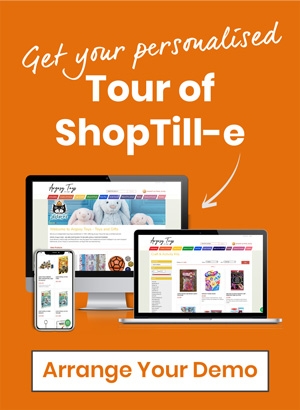In today's retail world, it's no longer enough to simply have a great product or a stunning shop. To truly succeed, retailers must be able to seamlessly integrate each aspect of their business; from their customers to their chosen sales channels, to their in-store and online sales and stock, as well as their sales data.
It's all about unlocking the power of retail integration, and it's a game-changer for businesses of all sizes.
By connecting all aspects of your retail business, retailers can streamline their operations, improve their customer experience, and ultimately take their business to the next level.
So, if you're ready to learn how to harness the true power of retail integration, then keep reading. We'll dive into the benefits, strategies, and best practices that will help you transform your retail business into a lean, mean, sales-generating machine.
The Benefits of Retail Integration
The benefits of retail integration are numerous and far-reaching. By connecting your customers, stock, sales, and sales channels, you can improve your business in a variety of ways. For example, you can:
Enhance customer experience: In today's digital age, customers expect a seamless shopping experience across all sales channels and by integrating your sales channels you can create that multichannel experience for your customers. It's also important for building brand loyalty and when customers feel connected to your brand, they are more likely to return for future purchases and recommend your business to others.
Increase sales: By embracing a multichannel approach, you can expand your reach and attract more customers than ever before. Whether it's through your retail shop, ecommerce website, social media, or online marketplaces, multichannel selling can help you connect with customers where they prefer to shop. Not only does this increase your chances of making a sale, it also helps to build stronger relationships and boosts loyalty.
Reduce costs: By streamlining your operations and reducing unnecessary admin, you can save money on staffing, inventory, and other expenses. This can help you improve your profit margins and reinvest in your business.
Improve efficiency: By integrating your sales channels with your stock levels, you can ensure that you always have the right products stocked on your shelves. By understanding stock levels everywhere this helps to avoid out of stock products, overselling and waste.
Stay competitive: By keeping up with the latest retail integration trends and technologies, you can stay ahead of the competition and position your business for long-term success.
Understanding the Key Elements of Retail Integration
To unlock the power of retail integration, you need to understand the key elements involved. These include:
Sales channels: Your retail shop creates that personal and immersive shopping experience that leads to loyalty, increased customer satisfaction and repeat business and your online shop provides convenience and the ability for your customer to research and shop on their terms. Online marketplaces allow you to reach an even wider audience increasing your sales potential, whereas social media allows you to connect with customers and promote your products.
Customers: By integrating all these sales channels, you can create a seamless, multichannel shopping experience for your customers that will ultimately increase your sales. By understanding their needs, preferences, and behaviours, you can create more targeted sales strategies and promotional campaigns.
Inventory: Your stock levels are critical to your success. By managing your stock effectively, you can ensure that you always have the right products, avoid out of stock items and overselling.
Sales: Your sales data provides valuable insights into your business. By analysing your sales data, you can identify trends, pinpoint areas for improvement, and make key business decisions.
Strategies for Successful Retail Integration
To achieve successful retail integration, you need to develop a strategy that considers your unique business needs and goals. Some strategies to consider include:
Invest in technology: There are a variety of tools and technologies available that can help you integrate your retail operations. These include inventory management software, customer relationship management (CRM) software, ecommerce platforms and point of sale systems also known as ePOS systems.
Create a unified customer experience: By integrating all of these sales channels you can ensure your promotions, products and customer data are consistent across all channels.
Integrated stock system: An integrated stock system allows you to track stock levels in real-time across all your channels. By having this information at your fingertips, you can make better decisions about your inventory, such as when to reorder products or which products to discount.
Use data to drive decision-making: By analysing your sales and customer data, you can make more informed decisions about marketing, sales, promotions and inventory management.
Focus on customer service: By providing excellent customer service, you can build stronger relationships with your customers and increase customer loyalty.
Best Practices for Retail Integration
To ensure that your retail integration efforts are successful, there are a number of best practices you can follow. These include:
Offline and online consistency: It's easy to get caught up in the idea that your offline and online sales channels are completely separate entities, however, this couldn't be further from the truth and shouldn’t be treated as such. They're simply different ways of reaching your customers, and maintaining consistency between your offline and online channels is essential to creating a cohesive and effective sales strategy.
Brand consistency: It's important that your branding, messaging, and customer experience are consistent across all channels for a stronger brand presence. Creating this consistent image, both online and offline, will build and maintain customer trust. Ensuring your ecommerce website showcases your retail shop means customers know who you are and by doing so, you're creating this seamless experience for your customers, whether they’re shopping in-store or online, which in turn can mean higher conversions.
Offer click and collect: By offering Click and Collect, not only are you giving your customer a choice of how to get their purchase but you’re also offering that unified shopping experience that they expect now.
Train your staff: Make sure that your staff are trained on the tools, technologies and software you're using for your integrated retail approach. If you're using ePOS system software or a new ecommerce plaform how easy are they to use? The more intuitive the software, the easier it will be to train your staff and will ensure everyone is on the same page and that your integration efforts are successful.
Be flexible: Retail integration is an ongoing process, and you may need to adjust your strategies and tactics as your business evolves.
Get social: Get customers on board and promote your latest products and trends to ensure they’re always uptodate with your stock and encourage them to visit your ecommerce website or come into your shop.
Challenges for Retail Integration
While retail integration offers many benefits, it can also present many challenges. Some of the most common challenges include:
Product and data management: Managing your data across multiple channels can be a complex and time-consuming process. There may be duplication and unnecessary admin involved if your using separate software or systems and they don’t talk with one another or share information seamlessly between them.
Additional costs: There may be additional costs if you're using more than one platform, system or software. There may be costs to get them to talk with one another and not all systems have the capability to share information between systems.
Stock levels: Managing stock across multiple channels can be tricky, if you sell in-store how is it reflected online and vice versa? If your stock levels are not shown in real-time there is the potential to oversell which leads to unhappy customers as well as additional administration on your part.
Integration of legacy systems: If you're using legacy systems that don’t track your stock and sales properly or aren't compatible with newer technologies, means your data will always be out of date, making business decisions difficult and stock levels and promotions a challenge.
Staff training: Ensuring that your staff are trained on your new systems can be a challenge, if the platform or software is overcomplicated and not easy to use it will be difficult to keep staff motivated and onboard with the new processes, leading to mistakes.
Solutions for Retail Integration
In conclusion, maximising your retail potential requires a seamless, unified connection between your customers, stock, sales, and sales channels.
By understanding your customers, streamlining your processes, and utilising the right retail software solution, you can improve efficiency, reduce your costs, and increase your sales potential.
However the challenges shown above cannot be ignored and that’s where ShopTill-e can help.
Your retail integration project doesn’t need to be expensive or complicated with ShopTill-e. The all-in-one retail management software takes away all the admin headache of getting separate systems to talk with one another and it makes it easy for retailers to sell multichannel with the seamless, unified sales channels and inventory.
Customer satisfaction, retention and building brand loyalty are key to success and ShopTill-e's all-in-one retail software delivers the seamless shopping experience that your customers now expect.
ShopTill-e can transform your retail business, taking it to new heights, as well as making your job easier. It’s a win, win!
Book a personalised demo today or try free for 14 days
ShopTill-e helps retailers save time, reduce costs and grow
It provides retailers with all the tools needed to sell in-store, online, on online marketplaces and social media and with all the features being automatically included, it really does help retailers save time, reduce costs and grow.
It includes a combined point of sale system, (also known as an ePOS system ) and full-featured ecommerce platform, with inventory management built in so you always know where you are with stock.
If you're looking for an all-in-one retail management software that will streamline your processes, make you more efficient and is cost-effective then look no further - book your personalised demo today.
"We switched from our current separated POS and website supplier to ShopTill-e due to issues of integration between the two different suppliers. With ShopTill-e the one system does both, saves lots of hours, and lots of headaches!
Small features which include gift vouchers automatically being used in store and online, as well as one place for all inventory, and reporting is a game changer. No more paying multiple subscriptions to multiple software supliers, by making the switch we save hundreds a month." Callum L - Director




